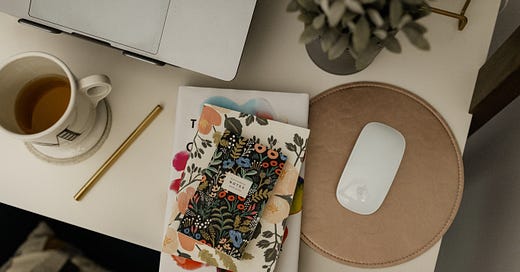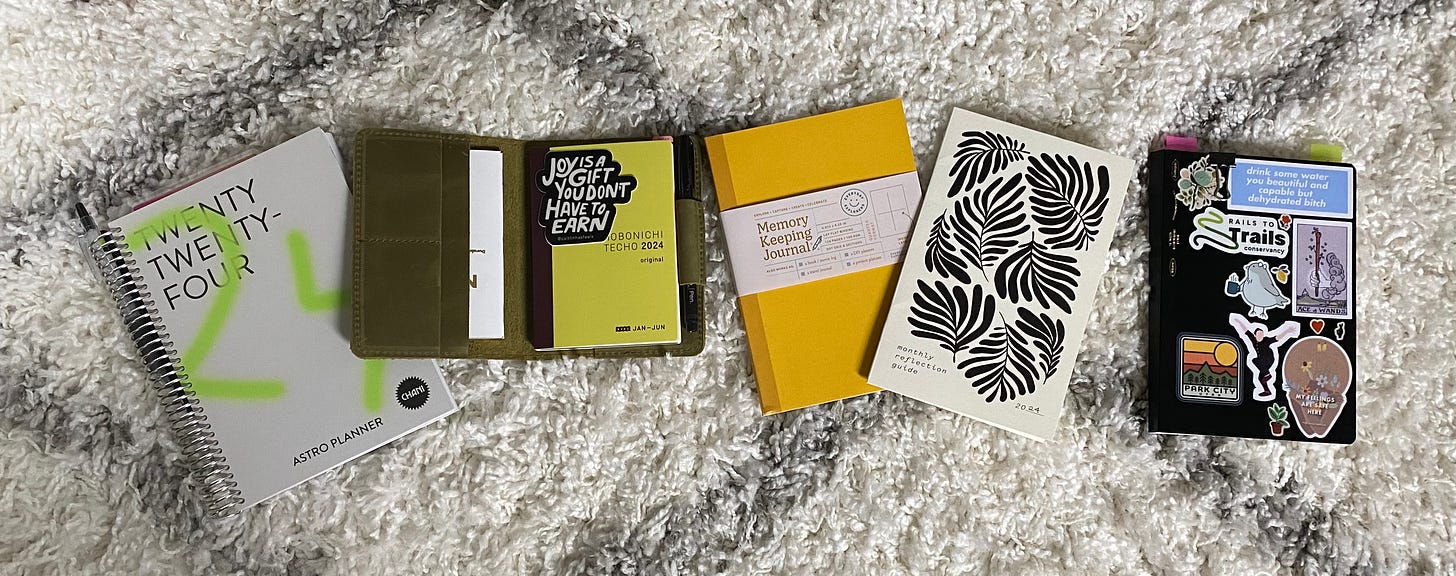The Webs We Weave ias a free weekly-ish newsletter on being in flux, staying connected to ourselves and our creativity, and feeling more connected in the world.
In the past month I’ve written about the magic of a weekly review practice, poetry as a tool for feeling our feelings, and lessons from last year’s Word of the Year. I love hearing which pieces resonate with you, so I can create more of them! 💛
Thank you, thank you, thank you for being here.
There's a Japanese phrase, techo kagai1, that's popular in the journal and planner community, which loosely translates to "planner meeting."
The idea is to sit down with all your planners, notebooks, and journals at the end of a year and do a gentle audit of your system: what's been working, what might need to change, and what you want to carry forward with you into the new year.
I've written before about how my approach to notemaking and curating my notebooks is not unlike planting a garden—and how this practice supports me mentally, emotionally, and creatively.
To be clear, I know basically nothing about tending to an actual garden. (Though, this is something I'd actually like to change this year!) But I do know on an intellectual level that a healthy garden requires year-round maintenance, involving different actions in different seasons. Better Homes & Gardens has this to say about garden maintenance in winter months:
Unwittingly, I took a similar approach when I sat down at the end of December to do my own techo kagai and audit my notemaking garden:
✔️ Audit and clear out what's rotting.
✔️ Plan ahead + gather what you need.
✔️ Fertilize what's already growing.
What Worked Last Year?
Last summer I shared a tour of the notebooks and containers that made up my notemaking ecosystem. My lineup at the time was essentially:
A weekly planner
A journal
A day-to-day notebook for capturing notes + ideas
A messy notebook for scribbles + brainstorms
A digital system for supporting my thinking + writing practice
"Some of these containers are are analog, and some are digital. Some are tidy and optimized for finding what I need later, and others are decidedly messy and unrefined. Each one tends to house something a little different, and without relying on rigid or dogmatic constraints about what belongs where, I find that I naturally reach for different vessels depending on what mood I’m in, and/or what I’m capturing or processing."
In many ways, this is a system that worked really well for me—enough containers to feel like I could bounce between them with my different moods and needs, without experiencing overwhelm. For the types of writing and notemaking I do, this was a really solid setup.
And yet... by the end of the year, I started noticing feelings of friction and mental scatter. The number of notebooks that once felt optimal now felt like maybe one too many—or at least, enough to introduce a sliver of decision fatigue.
Insignificant as it sounds, this subtle tipping of the scales matters. When you consider that the whole point of a notebook ecosystem is to support the work we want to be doing, even tiny hints of friction and distraction become red flags. For me, this was enough to signal it was time for some auditing and pruning.
A Framework for Auditing and Adjusting the System
As a shameless paper person and notebook hoarder, I know better than to let my paper-and-shiny-object-loving heart be the primary architect of any system I want to build. (If I did, I'd quickly drown in a sea of overwhelm and beautifully crafted paper products.)
Instead, I took more of a reverse engineering approach. And like so many projects, it began with a list.
After closing about a dozen open browser tabs of planners and notebooks I was coveting through the screen, I flipped to a blank page and made a list—not of the products I wanted, but of the needs I realistically have. For me, that list was highly specific to my personal rhythms and habits that already serve me well, which includes having:
A place to anchor into the present + see my tasks
A place to log what I'm learning + thinking about
A place to check in and reflect regularly (weekly + monthly)
A place to brain-dump and be unfiltered
Once I had my list of needs, it became much easier (and more fun!) to choose which vessels would fill each need.
📝 A few questions you might explore as you assemble your own notebook stack:
What are the types of things you find yourself capturing (or wanting/needing to capture) most often?
What do your natural tendencies look like when a thought, idea, or challenge strikes?
i.e., do you intuitively reach for your phone to jot something down? Is your workspace covered in little post-it notes with reminders on them? Do you have a notepad that’s already filled with pages of random lists?
What habits, rhythms, and/or products are already working well for you?
What are you missing or craving within your current system?
What could the simplest, minimum viable starting place look like?
My 2024 Notebook Stack at a Glance
One thing I've learned about myself is that I find a lot of creative joy in blowing up the system and changing things up once in a while. This realization helps me keep things breezy, taking the pressure off of finding or creating the perfect system and instead asking: what feels good right now?
In that spirit, the system I landed on for 2024 looks suspiciously similar to what I used in 2023, but with one less notebook and a couple of fun new product additions I'm swapping into the mix.
(None of the links below are affiliate links, though I don’t believe there’s anything inherently wrong with affiliate links! Just wanted to point you to the specific products I use, in case you’re drawn to them.)
📒 A place to anchor into the present + see my tasks:
Used for: weekly to-do menus, tasks, appointments, and other daily scribbles that help me root into the present.
📒 A place to log what I'm learning + thinking about
(aka, my Buddy):
Hobonichi 2024 Techo Avec (A6 size)
Used for: workshop notes, lists, ideas, brainstorming, experimenting with commonplacing, and generally creating a chronicle of what's on my mind.
(I'll note that I'm also using Tana as a digital tool to capture ideas and fodder to fuel my Substack writing practice, but that's a whole other post! Let me know if that's something you'd be interested in hearing more about.)
📒 A place to check in and reflect regularly
Everyday Explorers A5 Quarter Journal (weekly)
Monthly Reflection Guide from Caitlin Has Feels (monthly)
Used for: pausing to reflect, documenting my life in words and photos, and giving Future Me something to thumb through and remember what life right now looks and feels like.
📒 A place to brain-dump and be unfiltered (aka, my journal)
Stalogy Editor's Series 365Days Notebook in A5 (Grid)
Used for: morning pages when I do them, ranting, journaling, and other brain dumps that I rarely if ever plan to look back on and re-read.
What does your notebook ecosystem look like?
Feel free to adapt this framework for yourself—and let me know how it goes, if you do! I nerd out hard over getting to see other people's notebooks and systems, and I'd love to hear about yours.
Until next time,
Michelle
I was first introduced to the concept of techo kagai by
, but there's also a bottomless supply of techo kagai videos on YouTube just waiting to pull you down the rabbit hole if you're curious!









As someone who tends to put everything in either the Notes app, Google Drive, a morning pages notebook, or random sticky notes and they generally work fine for me, I don't always feel the *need* to overthink my "stack," but I *really* appreciate the simple act of actually considering what my needs are and what might best serve that purpose. It is the MOST fun to peek inside people's processes, so thank you for sharing yours! I obviously always want to see your digital note-keeping system!
Love your notebook stack! I use 2 planners -- a weekly and daily (which I wrote about this week, actually!); 2 A5 journals -- one for regular, long-form journaling & the other for ideas/brainstorming; and a couple of A6 journals that are focused on a single subject. Quite a big stack, but some of the journals are used only occasionally.
I’d love to hear about your digital idea tracking; I’m always curious about how other people brainstorm ideas!